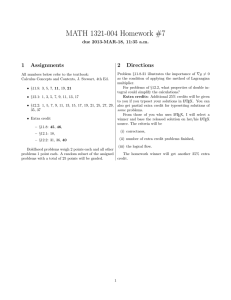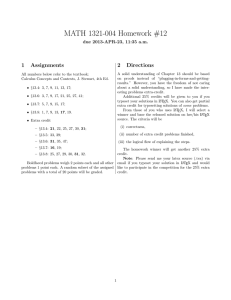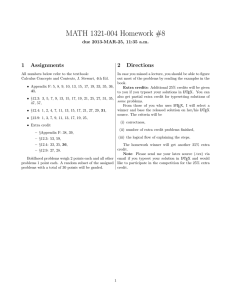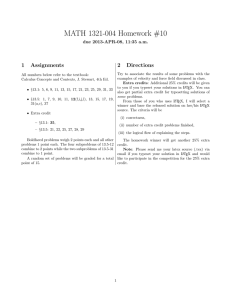Physics 251 - Syllabus, Fall 2014
advertisement
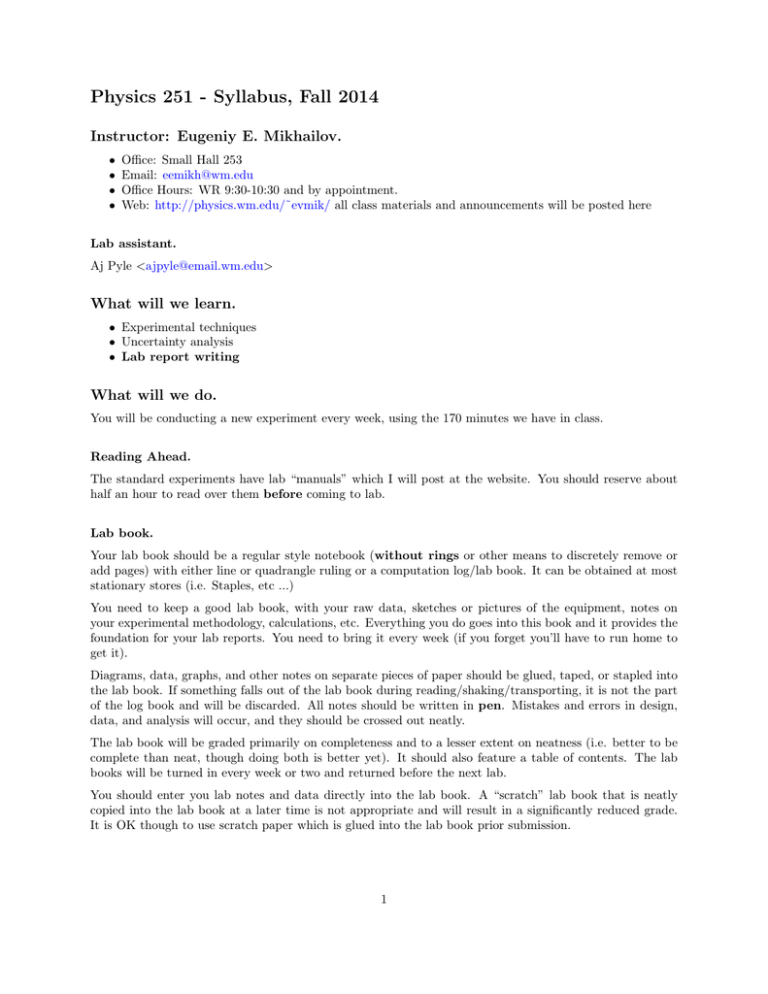
Physics 251 - Syllabus, Fall 2014 Instructor: Eugeniy E. Mikhailov. • • • • Office: Small Hall 253 Email: eemikh@wm.edu Office Hours: WR 9:30-10:30 and by appointment. Web: http://physics.wm.edu/˜evmik/ all class materials and announcements will be posted here Lab assistant. Aj Pyle <ajpyle@email.wm.edu> What will we learn. • Experimental techniques • Uncertainty analysis • Lab report writing What will we do. You will be conducting a new experiment every week, using the 170 minutes we have in class. Reading Ahead. The standard experiments have lab “manuals” which I will post at the website. You should reserve about half an hour to read over them before coming to lab. Lab book. Your lab book should be a regular style notebook (without rings or other means to discretely remove or add pages) with either line or quadrangle ruling or a computation log/lab book. It can be obtained at most stationary stores (i.e. Staples, etc ...) You need to keep a good lab book, with your raw data, sketches or pictures of the equipment, notes on your experimental methodology, calculations, etc. Everything you do goes into this book and it provides the foundation for your lab reports. You need to bring it every week (if you forget you’ll have to run home to get it). Diagrams, data, graphs, and other notes on separate pieces of paper should be glued, taped, or stapled into the lab book. If something falls out of the lab book during reading/shaking/transporting, it is not the part of the log book and will be discarded. All notes should be written in pen. Mistakes and errors in design, data, and analysis will occur, and they should be crossed out neatly. The lab book will be graded primarily on completeness and to a lesser extent on neatness (i.e. better to be complete than neat, though doing both is better yet). It should also feature a table of contents. The lab books will be turned in every week or two and returned before the next lab. You should enter you lab notes and data directly into the lab book. A “scratch” lab book that is neatly copied into the lab book at a later time is not appropriate and will result in a significantly reduced grade. It is OK though to use scratch paper which is glued into the lab book prior submission. 1 Lab reports. You will need to write a report for each of the standard labs. Though you will do the experiments in collaboration with a partner, your lab report is your own work. Lab reports are due at the start of class the following week, you need to bring stapled carbon copy of your report. Late reports will be docked 5% per day. In physics and mathematics LATEX is the standard program used to format papers. It’s great, especially for mathematical formulae, figures with captions, and tables. It’s available on Windows/Mac/Linux. A previous student says: “Just letting you know I used LATEX using TeXnicCenter as my editor. At first I was a bit skeptical because I felt Word could do just as much without having to build the Document to view it. But as experiments began to need more figures and equations I really started to enjoy latex because it was so simple. I could make gigantic equations like the Schrodinger’s equation in just a minute whereas word would have taken me quite a while. Anyways I’m really happy I learned to use LATEX and look forward to using it in the future.” AJ recommends to use TeXstudio. I personally prefer to edit LATEX files in a regular text editor and then compile it. I require you to use LATEX for report preparation. The lab report sample and LATEX template are provided at the class web site. The use of the “office” software is forbidden, i.e. MS Office, OpenOffice, LibreOffice, etc. Do not use jpeg format for the graph presentation. Points will be taken if we spot it. Use png or better yet eps or pdf formats. Analysis software. It might be tempting to use MS Excel for you analysis. I request to keep away from Excel and similar office tools. Moreover, I will not accept plots made in Excel or its analog. They are easy to spot, since they are ugly and have no notion of proper axes limits and formating. I suggest you to use Matlab which is very powerful and free for W&M students. I will be more than happy to help you with it. Also have a look at our class web site for matlab basics. Your might also use python (unfortunately, I will not be able to help you with it). Usually there is no “silver bullet” software which does good analysis and presentation, and you might invest some time to find a good plotting software as well. My personal choice is Gnuplot, though Matlab will do a good enough job most of the time. What to bring in class. Bring your laptop with analysis software satisfying above requirements. Do not bring your calculators. If I spot you with it, points will be taken. “Do not ride a bicycle if you have the starship Enterprise in your possession”. Bring your logbook and pen, this goes without saying. Everything else will be provided. 2 Lab rules. No food or drinks are allowed. We will occasionally work with high voltage, trust me that electrical shock is not the thing you want to remember from this class. Worthless looking pieces of glass which we use during optics related labs actually cost more than your smart phone. We do not want fingerprints on them. Lab visit. One week, instead of doing experiments, you will visit physics and applied science research labs, and maybe even talk with a theorist or two. You’ll write up a summary of your visit. Textbook. There is no required text for this class. However, as supplements I suggest: • Melissinos and Napolitano, “Experiments in Modern Physics”, 2nd Ed., Academic Press. • G. L. Squires, “Practical Physics”, 4th Ed., Cambridge. Sections. There are several independent sections for this class. In general, you cannot switch between them after the first experiment since you will have a lab partner and some of the experiments require at least two people. Physics 201 corequisite. Physics 201 is a corequisite of this class. However, unlike Physics 101/102, the two classes are separate and we do not try very hard to keep them in sync or make sure that 201 covers the theory behind a topic before 251 does the experiment. This is, more or less, how progress in physics really occurs! Experimenters usually do their work at the frontier where there is no theory or where there are multiple competing theories. Evaluations. Your final grade for the course will be determined from the following grading weight distribution: Lab reports and lab visit 75% Special project 15% Logbook evaluation 5% Lab participation 5% Occasionally I will make mistakes: typos, etc. If you report them or prove me wrong, you will get an extra bonus. I will drop the lowest lab score. However, in order to pass the class, you must do and turn in a report for all labs. You must also do the special project. Makeup labs are only allowed with prior permission and for a good reason or due to illness with a doctor’s note. Unlike 101/102 labs there is no reserved date. We’ll just deal with this as necessary. Grading. Grade Score percentage B+ C+ D+ F 87-90 77-80 67-70 <60 Grade A B C D Score percentage 94-100 84-87 74-77 64-67 3 Grade ABCD- Score percentage 90-94 80-84 70-74 60-64 Final exam. There is no final exam but the final presentation of your special project. • Wednesday section: December 3, 2pm (during normal class time) • Thursday section: December 4, 2pm (during normal class time) 4

